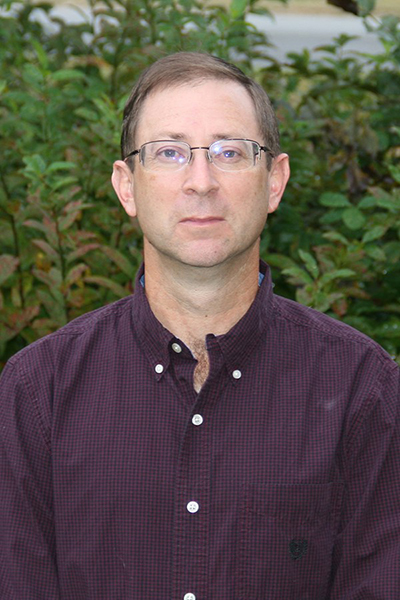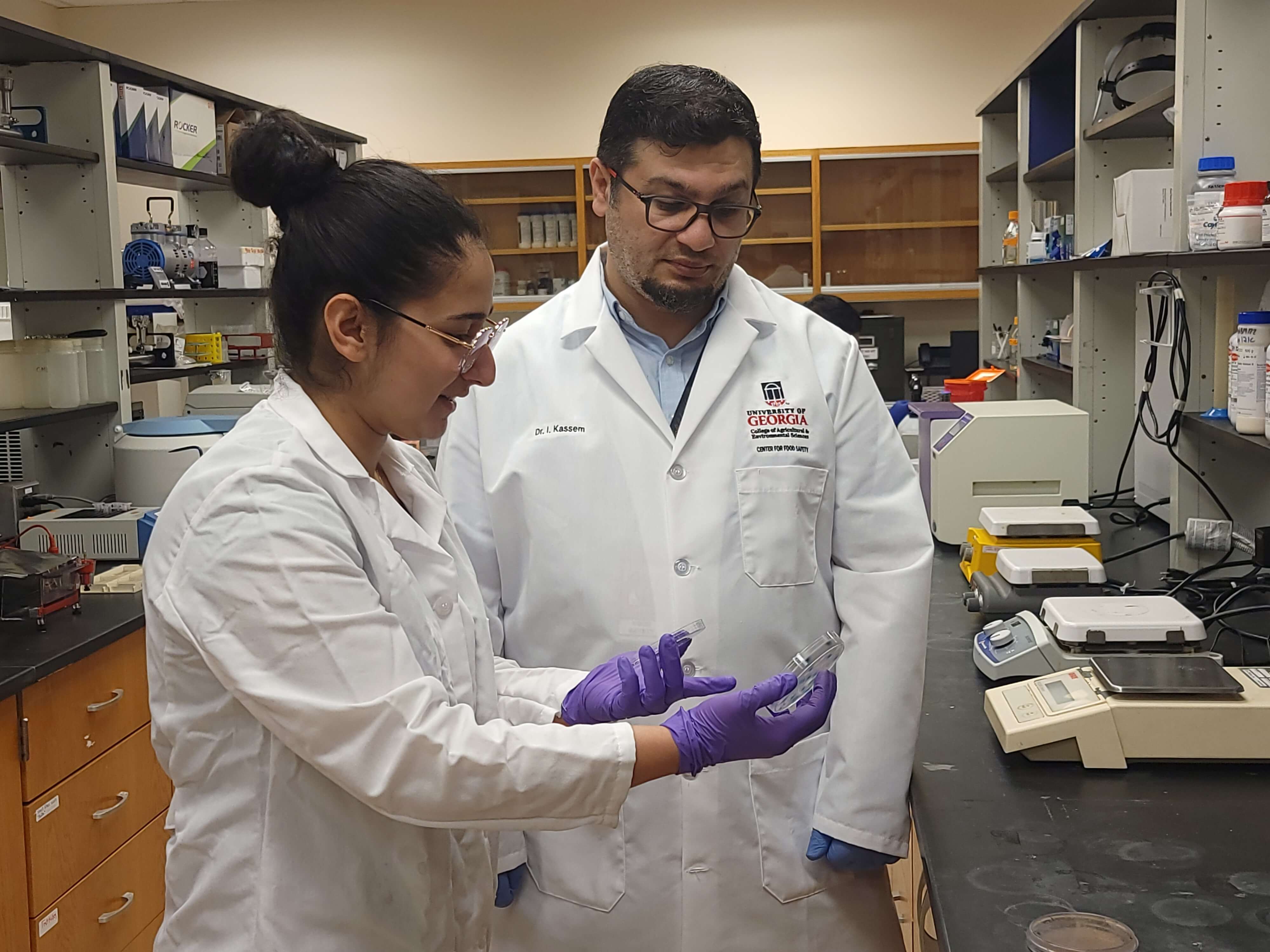.jpg)
Georgia is the nation's leading pecan-producing state — and University of Georgia researchers intend to keep it that way. Working with an international team of experts, four faculty from the UGA College of Agricultural and Environmental Sciences (CAES) have received a U.S. Department of Agriculture National Institute of Food and Agriculture award for the second phase of a study to adapt one of Georgia’s top commodities, the pecan.
The $737,227 award will further their interdisciplinary research project, called “Trees for the future: Coordinated development of genetic resources and tools to accelerate breeding of geographic and climate adapted pecans.”
The grant narrative explains that “climate extremes, pest and pathogen shifts, and changing consumer preferences apply ever-increasing pressures on crop breeders.” The pecan, which has long juvenile periods of 15 to 20 years before trees begin to produce, presents a particular challenge for breeders and producers.
The overall grant includes five major objectives:
- Leveraging pecan genetics towards breeding pecan trees for climate adaptation;
- Describing physiological differences of water relations among pecan genotypes to improve water-use efficiency;
- Characterizing interactions of pecan trees with beneficial and detrimental organisms for improved tree health, reduced pesticide application and increased production;
- Elucidating pecan gene networks and markers that control reproductive traits such as flowering, nut size and kernel biochemical composition; and
- Using pecan genetics to determine markers for pecan tree architecture and growth.
“Pecan is a very important crop for the economy of the state of Georgia and the Southeast United States and it is also a very nutritious nut with proven health-promoting characteristics,” said Leonardo Lombardini, professor and head of the CAES Department of Horticulture. “The team of scientists leading this project will be able to investigate a broad range of aspects that drive pecan production and consumption, from the genetic make-up of pecan varieties to the nuts’ postharvest attributes. With their extensive expertise, they will deliver important results to help select varieties that will perform well under Georgia environmental conditions and will produce high quality, nutritious nuts.”
International research efforts
Program staff includes experts from CAES, New Mexico State University, USDA-Southeastern Fruit and Tree Nut Research (SEFTN), Texas A&M University, University of California Agriculture and Natural Resources, USDA Pecan Breeding and Genetics (PBG), University of Tokyo, Hudson Alpha Institute, USDA Southern Regional Research Center, University of Arizona and Oklahoma State University.
Representing CAES in the project are Patrick Conner, professor and UGA-Tifton research, Extension and instruction (REI) coordinator in the Department of Horticulture; Lenny Wells, professor and UGA Cooperative Extension pecan specialist in the Department of Horticulture; Joonhyuk Suh, assistant professor in the Department of Food Science and Technology; and Ronald Pegg, Josiah Meigs Distinguished Professor in the Department of Food Science and Technology.
Conner said the collaboration came to fruition after experts attending a pecan meeting held by the International Society of Horticultural Science looked at what was holding them back from tackling this research. A core group came together, representing all aspects of the pecan, from breeding to genomics. The team applied for an initial grant which was funded in 2016 and most of the group reassembled for the current project team.
“A majority of universities with strong pecan background as well as two USDA sites that focus on pecan are represented,” Conner said. “Our work depends on region — wet climates are focused on issues like scab while arid climates are focused on water use efficiency, soil salinity, etc.”
CAES researchers bring expertise in pecan breeding, hedging and metabolomics

Patrick Conner
Conner’s first objective is focused on exploring the interaction between the fungus Venturia effusa, which causes pecan scab, and the pecan.
“Scab is a fungal pathogen common in the Southeast, which is spread by water on the leaf surface,” Conner said. “Scab infection can be very severe and can result in total crop loss on susceptible varieties in a wet year.”
He is studying the genetics of resistance by making high-density genetic maps in two pecan progenies, or offspring, that are segregating for scab resistance.
“We hope to find regions of the genome that are associated with scab resistance,” Conner said. “This will better help us understand the genetic control of resistance and may also produce DNA markers that can be used to select resistant seedlings in our breeding populations.”
Conner’s end goal is to have more resistant varieties released so producers can spray less — ideally two or three times per year instead of nearly 20.
“We want to enable a more sustainable process of growing pecans in our region,” he said.
A second objective in Conner’s work involves characterizing pecan nut morphological — or structural — diversity. Complete pecan nut halves are more valuable in the market, leading Conner’s team to study a range of traits including nut length and width. His team is analyzing the shape of more than 700 native trees collected from the wild by the USDA.
“We will then genotype these same trees with thousands of genetic markers and look for associations between the markers and the nut shape characteristics through a process called Genome Wild Association Study (GWAS),” Conner said. He hopes this process will indicate regions of the pecan genome that control important nut shape traits.

Lenny Wells
Wells’ role in the project is to examine the potential effect of hedge pruning on bacterial leaf scorch (BLS) of pecan, which can cause defoliation and reduces tree growth and kernel weight.
“Hedge pruning is a management practice in which trees are pruned by removing all growth on the tree extending past a certain distance — usually 6 to 8 feet — from the trunk along the length of the tree row and we reduce the height of the tree,” Wells said. “This creates a smaller, more compact tree, which has multiple advantages.”
Wells’ earlier research with hedge pruning demonstrated that hedge-pruned trees are less water-stressed and potentially more efficient in their use of water than non-hedged trees under the same irrigation schedule.
With the same size root system and less tree to feed, hedged trees can be more vigorous and produce larger and better-quality pecans.
“Hedge pruning also helps to manage the crop load, preventing the excessive cropping which stresses the tree. We are trying to determine if hedge pruning can help reduce the two major stresses — excessive crop load and drought stress — which often lead to symptom expression of BLS,” Wells said.

Joonhyuk Suh and Ronald Pegg
Across their research at CAES, Suh and Pegg focus on applying chemistry to food science to improve food and food product quality, such as nutritional quality, safety, flavor and color. Pegg’s research includes functional foods, nutraceuticals (a food containing health-giving additives), identification of bioactive compounds, and their benefits.
Suh’s research focuses on metabolomics to identify and characterize small-molecule chemical compounds — called metabolites — related to the phenotype (e.g., flavor, color, status, resistance to stress) of food crops and products.
“Consumer acceptability of food products is a driving factor for adopting food production and processing technologies,” said Manpreet Singh, professor and head of the Department of Food Science and Technology. “Food science and technology is at the intersection of this food production and consumer acceptance nexus and Drs. Suh and Pegg are eminent researchers in this area. One of the goals for the department is to have cross-disciplinary collaborations and enhance the potential of Georgia-grown commodities such as pecans by elucidating the nutritional quality, flavor and color stability using metabolomics.”
For this project, their role is to find key metabolites that are associated with DNA markers obtained from Conner’s research of certain objectives (like pecan scab resistance and morphological properties).

“For example, if we found metabolites that are highly correlated with pecan color, they might be used as biomarkers for pecan breeding to select pecan trees with a desirable color,” Suh said. “To discover those metabolites (biomarkers), we will use a modern approach called metabolomics — the large-scale study of metabolites — involving instrumental analysis and big data interpretation.”
Pegg added that while chemistry in food crop breeding is still in its infancy, it has been rapidly growing as breeding strategies have gradually changed from producer-centered to consumer-assisted selection — consumers want products with better nutritional quality, flavor and color, characteristics derived from chemical compounds.
“Our goal for this project is to support a pecan breeding program selecting pecans with desirable traits, based on chemistry information (metabolites),” Pegg said. “We believe our research will be a pioneer to incorporate chemistry into breeding science and related fields.”
While the research process on the four-year grant is just beginning, the results could impact pecan growers and consumers decades into the future.
“The project as a whole covers a lot of ground that features work by a lot of great scientists,” Wells said. “I hope we are able to generate more basic knowledge of how pecan trees work and also provide practical answers that are of direct benefit to producers in both the short and long term.”
To learn about additional UGA pecan research, view pecan-related Extension publications and access additional resources, visit pecans.uga.edu.






